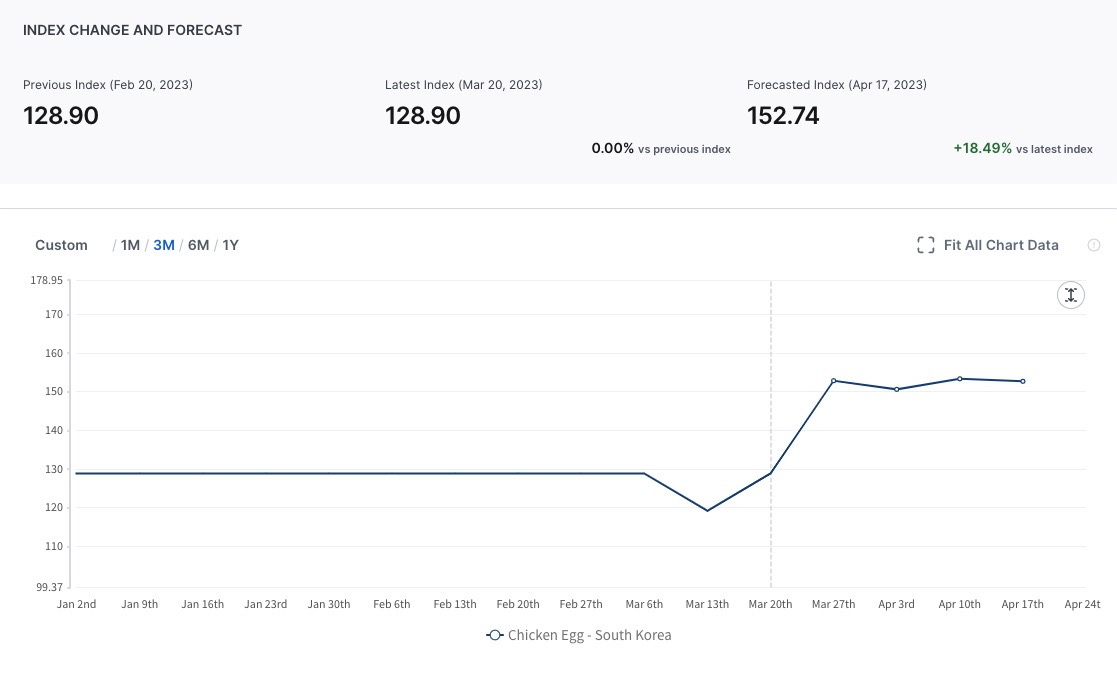Why Did Chicken Egg Prices in South Korea Remain Low in Q1 of 2023, While the Majority of Countries Faced Surge?

Reduced egg production and the global outbreak of avian influenza (AI) caused the shortage of eggs in many countries. It led to supply chain disruptions in the global egg and poultry market. While many countries face the surge in egg prices, South Korea can observe a completely different scenario. According to the Korea Institute for Animal Products Quality Evaluation, as of February 20, 2023 , the price at production farms for 30 eggs(extra-large size egg between 60g and 68g each) carton was 4091 KRW (about 3.14 USD, as of March 29 2023), which was 136.36 KRW per egg (about 0.10 USD, as of March 29 2023). For comparison, in the similar period chicken eggs in South Korea were around291% cheaper than in the USA, 49% cheaper than in Europe and 36% cheaper than in Japan. According to Tridge’s recent data on Egg Price Index Change in South Korea, it can be seen a stable price trend during the 2023 Q1.
Figure 1: Chicken Egg Price Index Change and Forecast in South Korea for January-April 2023

Source: Tridge
As can be seen from the analysis above, Korean chicken egg prices remained significantly lower than the rest of world amid avian influenza (AI) outbreak. There are several reasons why chicken egg prices in South Korea became cheap during the Q1 of 2023. The primary reason is that South Korea is less affected by avian influenza (AI) than other countries. According to the Ministry of Agriculture, Food and Rural Affairs of the Republic of Korea, as of mid March 2023, the number of total avian influenza (AI) in Korea was 71 cases, similar to Japan (79 cases), but the number of laying hens killed was 19.4% (2.86 million) of Japan (14.73 million). According to the US Department of Agriculture, avian influenza (AI) has killed more than 50.54 million birds in the United States in 2022, making it the country's deadliest poultry virus in history. Korean Health authorities also imposed effective measures to ease the avian influenza (AI) outbreak within a radius of 3km to within 500m of the outbreak. Another reason for the price drop of chicken eggs in Korea was an increased supply by poultry farmers. Daily egg production in South Korea in 2022 reached 44.12 million pieces. Lastly, the Korean Government’s release of 15 million stockpiles before the Lunar New Year holidays, including 1.21 million of imported fresh chicken eggs from Spain which were sold below the market price, contributed to a price drop in Korea during the Q1 of 2023.
To sum up, oversupply of chicken eggs to the domestic market in South Korea by poultry farmers has caused a price drop in Q1 of 2023. The supply in the market exceeded the demand. Regardless of external factors in production, Korean chicken egg producers are supplying more eggs than the market demand. However, chicken egg producers are losing money from each egg sold instead of earning. In mid March 2023, the wholesale price of egg was 144 KRW per unit which was not even close to the production cost of 150 KRW per unit. The Korean government has not taken any actions yet to support local egg producers.
Recently, chicken egg production costs are rising in South Korea as a result of avian flu, rising fuel, poultry feed, price of egg laying hens, labor and packaging costs. Overall production costs in the last 2 years have increased 30-50%, according to the Korea Poultry Association. Poultry farmers are now less interested in further expansion of their production capacity in the upcoming months. Government’s recent import of 1.21 million eggs from Spain evoked discontent among poultry farmers arguing that it’s already oversupplied required chicken eggs. According to the Korea Poultry Association, the Korean chicken egg market is relatively small and local egg producers can meet the demand more than required and there is no need to import chicken eggs from overseas.
The Ministry of Agriculture, Food and Rural Affairs of the Republic of Korea commented on the necessity of preparedness for any difficult situation amid the global outbreak of avian influenza (AI). Currently, in the chicken egg market if the supply side is going to be decreased, egg prices seem to be stabilized. The Korea Poultry Association stated that since there is egg surpass in the local market, Korean egg producers are hoping for government support to export eggs to countries like Taiwan, Hong Kong, Singapore, Japan where egg shortage can be observed. Industry experts believe that the chicken egg market in South Korea will be stabilized in upcoming months. Supply and demand will be normalized and price will be determined by the market.





